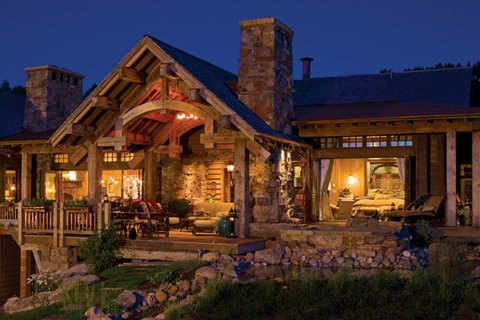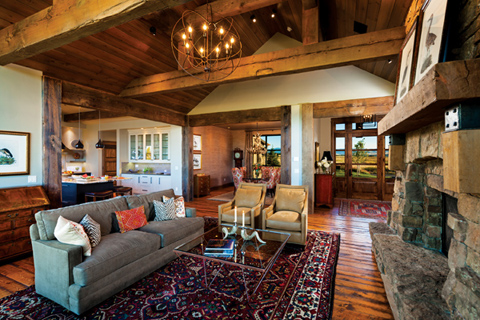You know the saying, “It takes a village to raise a child.” Well, the same could be said of building a log or timber frame home. Your log producer, builder, and contracted experts in plumbing and electrical systems are all critical to building a successful new home, and interior design expertise is just as important. Having a professional you can rely on to guide you through each step of the design process makes building a home more manageable and can actually end up saving you money and time.
Building a Team
Interior Designers are qualified by the American Society of Interior Designers (ASID), which has specific membership requirements and a code of ethics. The ASID’s website (asid.org) offers consumers helpful resources, including information about green and universal design principles. A qualified interior designer will help you determine more than just colors and textures. Designers get involved from the very beginning of the planning process and can help you make choices about space planning, layout, and materials. An interior designer will understand both the building process and code requirements and help advise you within that framework.
Some log and timber frame producers have in-house interior design services that can work hand-in-hand with your builder to ensure continuity in design throughout your home. This allows seamless communication between designer and builder. One example is Wisconsin Log Homes, in Green Bay, Wisconsin. “I am involved in every project. I work directly with our in-house builder as well as with our sales team,” says Cassandra Christianson, interior designer at Wisconsin Log Homes. “When I meet with clients I will select everything for their home from exterior stain to roofing products and shingles, and interior elements like flooring, appliances, cabinetry, finishes – anything that goes into the building I help with.”
The Designer’s Role
Before you hire an interior designer, talk to your builder about the scope of work you expect. “I work on so many different levels with different clients—it just depends on how far the architect and builder want to go,” says Erika Jennings, principal designer and owner of Carole Sisson Designs in Big Sky, Montana. “I have one client where I’m mostly a sounding board, but I go from that to completely creating every specification right down to appliances and plumbing.” Christianson notes that some interior designers don’t have experience with exteriors, so if that’s something you want included in the scope of work, it’s important to establish that right off the bat.

Photo by Karl Neumann
Bringing an interior designer in at the beginning of your project is important. “Getting involved early on is the best way to go,” says Jennings. “It’s so important to me in an early stage to meet the team, to make sure the architect, the builder, the homeowner, and the designer all have communication and no one is left out of the loop.”
Of course, even the best interior designers are only as good as the information they receive. Solid lines of communication from day one help ensure everyone is on the same page and prevent things from falling through the cracks. “One of the first things I ask a potential client is, ‘What do you hope to get from me?” I modify the way I work based on how the client wants to work with me,” says Jennings.
Every client has unique needs. To ensure you get the results you want, it’s essential that you communicate clearly about not only your likes and dislikes, but about your lifestyle. This enables your designer to make educated recommendations for both form and function that reflect your personality. Christianson advises her clients to browse online photos at sources like Houzz.com to be prepared for initial planning. “If clients bring photos to our meetings, that helps me to get a feel for what they’re envisioning,” she says.
Sometimes a designer’s role will be to help educate you about the best ways to plan your home. “A lot of times clients will come to us with an idea of how they want their house laid out, but it doesn’t make sense from a functional standpoint,” says Christianson. “We help them understand the building process, and why it makes sense to do things a certain way.”
Log and Timber Experience
Hiring an interior designer with experience working on log and timber frame homes is important, as they pose unique design challenges that you may not see in conventionally constructed houses. “Log homes make placement of art and furniture on walls a little different, and log homes can settle so you have to keep that in mind,” says Jennings. “A lot of people we work with have never built a log home before so they rely on my guidance,” says Christianson.
A designer with the right experience can help you maximize your log home’s natural beauty.
A wood home is an ideal canvas for custom touches like a one-of-a-kind mantel, dramatic hand-forged lighting, or custom entry doors, so look for a designer that has an appreciation for the design potential your log or timber frame home offers. “It’s a completely different style of home,” says Christianson. “The colors and selections typically are going to be a little bit different than what you would choose for a traditional home.”
Working with an interior designer should be a partnership between the client, designer, and builder. With an effective working relationship, a professional designer will help ensure that your home is not only beautiful but perfectly suited to your family’s lifestyle.

